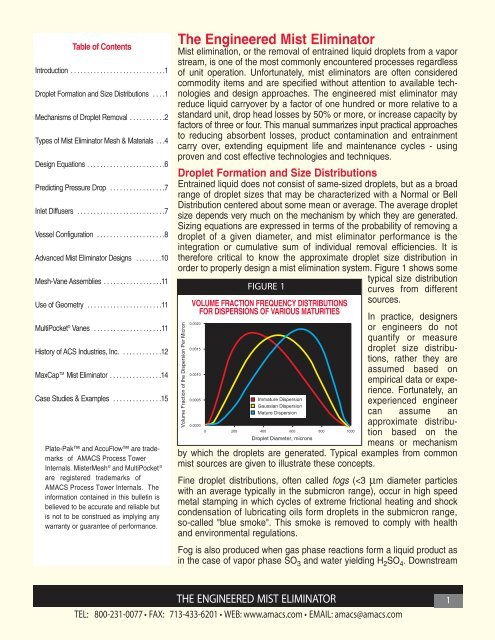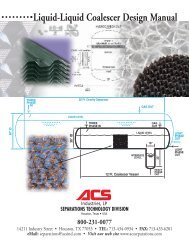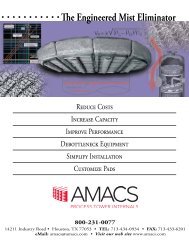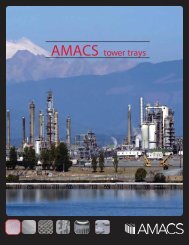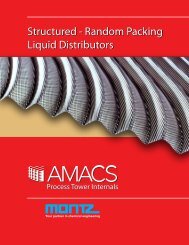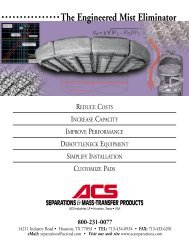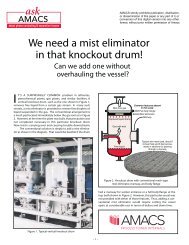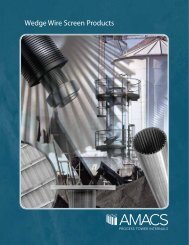Mesh and Vane Mist Eliminator Brochure - AMACS Process Tower ...
Mesh and Vane Mist Eliminator Brochure - AMACS Process Tower ...
Mesh and Vane Mist Eliminator Brochure - AMACS Process Tower ...
Create successful ePaper yourself
Turn your PDF publications into a flip-book with our unique Google optimized e-Paper software.
Table of Contents<br />
Introduction ............................ .1<br />
Droplet Formation <strong>and</strong> Size Distributions ... .1<br />
Mechanisms of Droplet Removal .......... .2<br />
Types of <strong>Mist</strong> <strong>Eliminator</strong> <strong>Mesh</strong> & Materials . . .4<br />
Design Equations ....................... .6<br />
Predicting Pressure Drop ................ .7<br />
Inlet Diffusers .......................... .7<br />
Vessel Configuration .................... .8<br />
Advanced <strong>Mist</strong> <strong>Eliminator</strong> Designs ....... .10<br />
<strong>Mesh</strong>-<strong>Vane</strong> Assemblies ................. .11<br />
Use of Geometry ...................... .11<br />
MultiPocket ® <strong>Vane</strong>s .................... .11<br />
History of ACS Industries, Inc. ........... .12<br />
MaxCap TM <strong>Mist</strong> <strong>Eliminator</strong> ............... .14<br />
Case Studies & Examples .............. .15<br />
Plate-Pak <strong>and</strong> AccuFlow are trademarks<br />
of <strong>AMACS</strong> <strong>Process</strong> <strong>Tower</strong><br />
Internals. <strong>Mist</strong>er<strong>Mesh</strong> ® <strong>and</strong> MultiPocket ®<br />
are registered trademarks of<br />
<strong>AMACS</strong> <strong>Process</strong> <strong>Tower</strong> Internals. The<br />
information contained in this bulletin is<br />
believed to be accurate <strong>and</strong> reliable but<br />
is not to be construed as implying any<br />
warranty or guarantee of performance.<br />
The Engineered <strong>Mist</strong> <strong>Eliminator</strong><br />
<strong>Mist</strong> elimination, or the removal of entrained liquid droplets from a vapor<br />
stream, is one of the most commonly encountered processes regardless<br />
of unit operation. Unfortunately, mist eliminators are often considered<br />
commodity items <strong>and</strong> are specified without attention to available technologies<br />
<strong>and</strong> design approaches. The engineered mist eliminator may<br />
reduce liquid carryover by a factor of one hundred or more relative to a<br />
st<strong>and</strong>ard unit, drop head losses by 50% or more, or increase capacity by<br />
factors of three or four. This manual summarizes input practical approaches<br />
to reducing absorbent losses, product contamination <strong>and</strong> entrainment<br />
carry over, extending equipment life <strong>and</strong> maintenance cycles - using<br />
proven <strong>and</strong> cost effective technologies <strong>and</strong> techniques.<br />
Droplet Formation <strong>and</strong> Size Distributions<br />
Entrained liquid does not consist of same-sized droplets, but as a broad<br />
range of droplet sizes that may be characterized with a Normal or Bell<br />
Distribution centered about some mean or average. The average droplet<br />
size depends very much on the mechanism by which they are generated.<br />
Sizing equations are expressed in terms of the probability of removing a<br />
droplet of a given diameter, <strong>and</strong> mist eliminator performance is the<br />
integration or cumulative sum of individual removal efficiencies. It is<br />
therefore critical to know the approximate droplet size distribution in<br />
order to properly design a mist elimination system. Figure 1 shows some<br />
FIGURE 1<br />
VOLUME FRACTION FREQUENCY DISTRIBUTIONS<br />
FOR DISPERSIONS OF VARIOUS MATURITIES<br />
typical size distribution<br />
curves from different<br />
sources.<br />
In practice, designers<br />
or engineers do not<br />
quantify or measure<br />
droplet size distributions,<br />
rather they are<br />
assumed based on<br />
empirical data or experience.<br />
Fortunately, an<br />
experienced engineer<br />
can assume an<br />
approximate distribution<br />
based on the<br />
means or mechanism<br />
by which the droplets are generated. Typical examples from common<br />
mist sources are given to illustrate these concepts.<br />
Fine droplet distributions, often called fogs (


